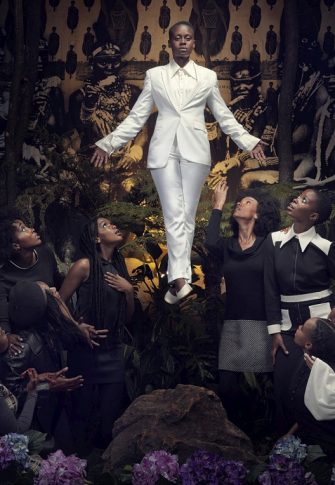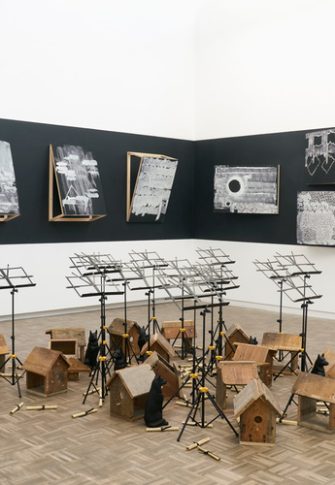Chad Rossouw: There have been some shifts from your previous work, most obviously a preponderance of green in your palette as opposed to blue. There is also a rougher, looser handling of paint, as well as moments of impasto which have not always been part of your normal vocabulary. What’s behind these shifts?
Virginia MacKenny: This is clearest in Dancing with Doubt, which has the biggest contrast between quite standard illusionistic painting and impasto. It’s a core painting on the show. I want to work more loosely: I prefer looser painting, even though my own painting is quite tight.. But I also wanted to find another means to animate a visual image. This particular one came from quite a simple photograph, of two dogs fighting. I removed one and it left it with quite a heraldic quality. I had a sensation that the painting was about the anxiety of this contemporary moment, and I made a great big squodge of chromatic black paint. I put it onto the canvas and squished it around a bit and thought ”Oh my god… I’m not used to working like this. I think I’ll have to come back to this.” The next day, Michaelis was shut down. I was kept out of my studio for two months. The student shutdown, which had already been part of the anxiety on campus, suddenly became manifest in a very physical way in relation to the paint. By the time I got back into the studio, having found that time considerably difficult, very very difficult in fact, I was faced with this thing. But it was no longer squishy, it was sealed and half-dried. I didn’t know what to do with it, because it embodied the moment so much. It had been sitting there all during that period, and it felt energetically, like it stood for itself. I was looking for a sensation, some sort of sensation in my middle, rather than intellectually. This painting is bifurcated by one vocabulary of painting and another. So formally it is quite a challenge in the sense that it is trying to marry these two different modes of making. That’s interesting to me as a painter, but quite tricky.
CR: Can you talk through the shift of colour as well?
VM: My last exhibition was entirely blue, but a long long time ago, when I first started painting, my work was dominated by green. I started out as a fairly traditional landscape painter, so there is a vocabulary of green in my past. But now, I needed a different kind of engagement with my sense of being in the world. Blue is a distancing and detaching colour, it allows things to float, it is ethereal and it renders unmarkable spaces: the sky and the ocean. Neither of them are fixed, they are untethered. And it has to do with a sense I’ve always had that life is a vertiginous experience, you hang between birth and death and we experience life as uncertainty.
However, in this work the green is an attempt, on one level to ‘ground,’ to connect to an older tradition of landscape painting, rather than the freer space of sea and sky.
CR: Green is normally a passive, calming colour, but you are using it here to evoke a certain anxiety.
VM: The green is ‘amped’. It’s not a natural tree-and-hills kind of green. It’s a highly synthetic green. It’s phthalo green, and Hookers green and they are both used in a way that highlights their synthetic artificial quality. Most of the greens are ‘off’, they’re skew.
CR: One thing you mentioned is with blue, things could float together. You could juxtapose things easily. But that is still something you haven’t given up pictorially. Why is it important to you, to have a multiple images in a single frame?
VM: It’s because I don’t think we know where we really are. I think that to attempt to find places of stasis or certainty now is virtually impossible. So the sense of spatial dislocation registers a sensation of change and anxiety and internal dislocation. I don’t think we are grounded. I think there is a serious need to become reconnected to things we have forgotten. We are in serious trouble in terms of climate change, in terms of that disconnect with the earth. One of the ironies of the show is that it represents, animal life and the environment, but we may end up only with representations of what our world is, and this exhibition is an example of that. It’s calling us to look to connection but it is already a representation, it’s already a removed state. But it is a call to open a heart space, to ask you to think and feel.
CR: What is the concept with the Sand’s Edge? There is a little dissonance in the title. It could be the edge where things are flaking out, and washing away, it also speaks of beaches and holidays.
VM: People have described sand as a fifth element, somewhere between being a liquid and a solid, and always potentially in movement. But we don’t know when it’s going to move, so there is a kind of indeterminacy about it. There is the sense of it being the place of erosion, but also the place of play.
Sand is also a biblical thing: Don’t build on the sand, it will crumble. And we’ve done a lot of building on sand. We’re not aware of the sand’s edge, we don’t seem to be taking into account long held life lessons. So while there is not that much sand visible in this exhibition, it’s not about illustrating it, its about evoking something of things I associate with it.
CR: One of the things that strikes me is an anxiety around representation, and images taking over the world. The idea that all we have left is the images, the representations.
This is in a sense an elegiac space, a mourning space. There’s grief here. In terms of the making of the work, there is an awareness: what are we making more things for? I make paintings because it helps me to think through what it means to be alive at the moment. It allows me to think and feel my way through where I am.









